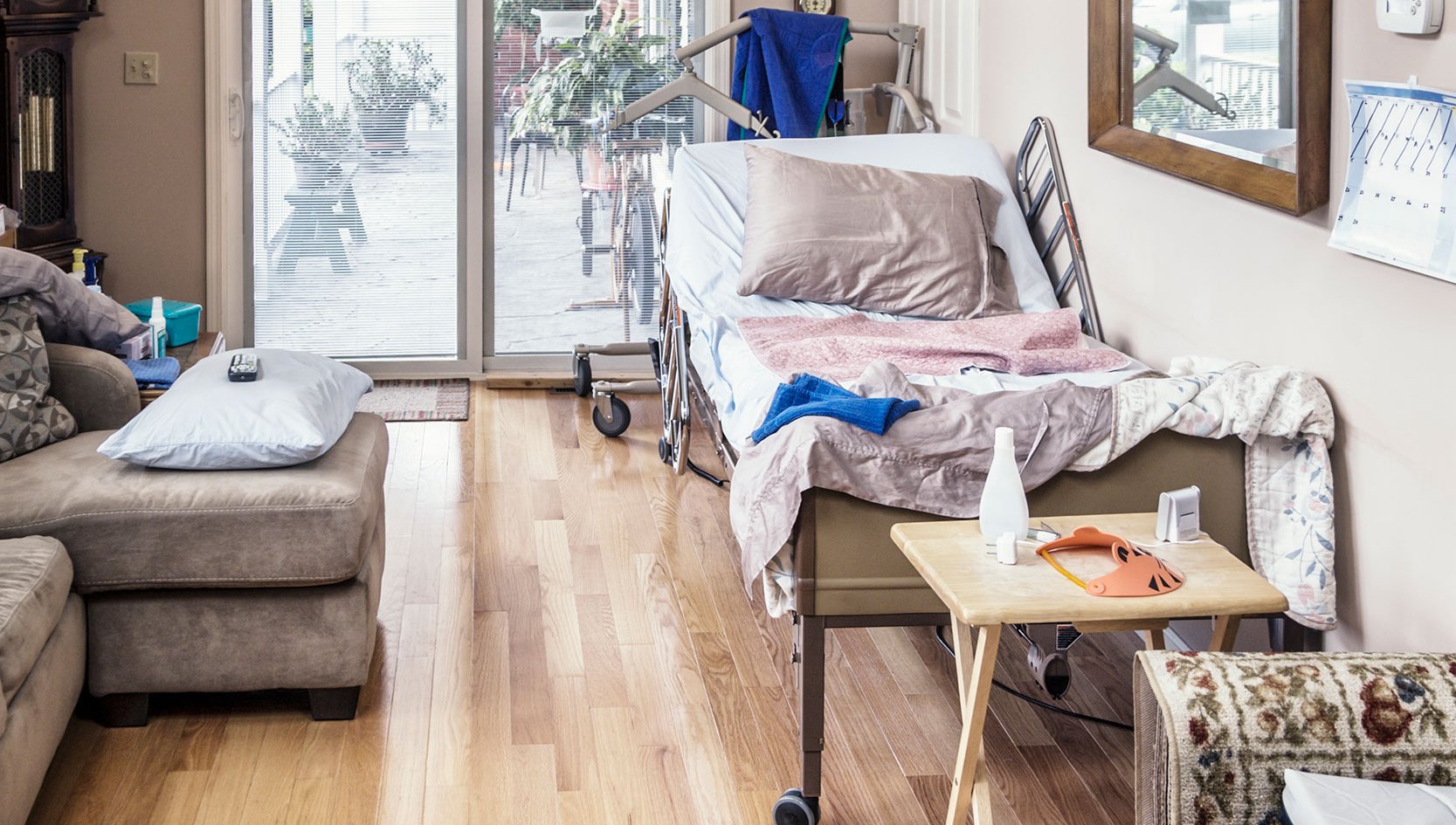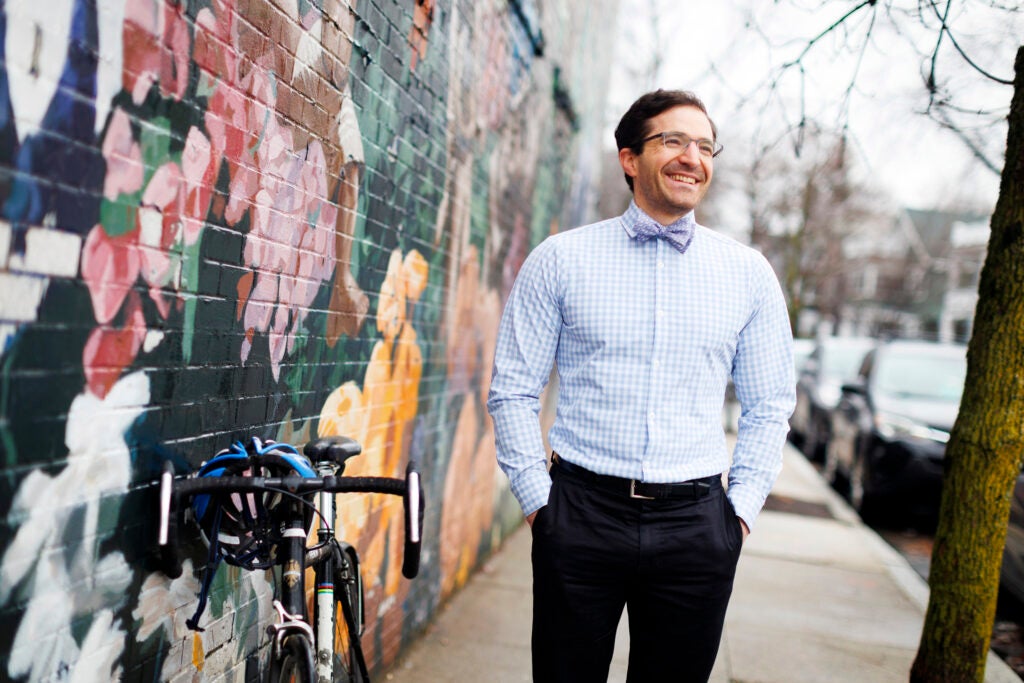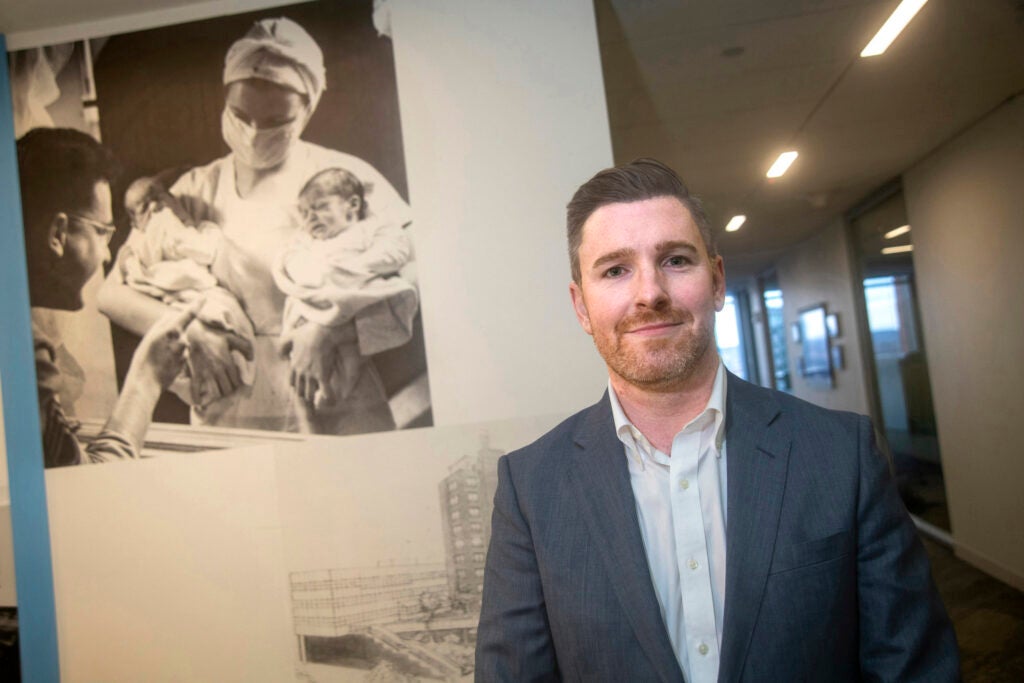
What if the hospital was at your house?
Study finds ‘acute’ care at home effective, improves patient experience — could slow rising healthcare costs
Recent advances in technology have enabled a cheap, effective way to expand the nation’s number of hospital beds while maintaining or even improving care: Put them at home.
Research led by David Levine, an associate professor at Harvard Medical School and a physician at Brigham and Women’s Hospital, showed that “acute” hospital care, serious enough to typically require an inpatient stay, can be effectively provided at home, with favorable results.
“If you need intensive care, well, that’s not what home hospital does, or if you need surgery, that’s not what home hospital does,” said Levine, who is also director of home hospital for Ariadne Labs, a joint center of the Brigham and the Harvard T.H. Chan School of Public Health. “But if you need general medical or surgical ward care and you fit into one of the evidence-based diagnostic buckets, then I wouldn’t ever want to care for you anywhere other than in your home.”
Since January 2022, thousands of patients across the country have been treated at home under a temporary Medicare and Medicaid waiver that expires later this year. Levine and colleagues examined outcomes for 5,132 patients treated at home for conditions such as heart failure, respiratory infection — including COVID-19 — sepsis, kidney and urinary tract infections, and cellulitis. Many of those cases were medically complex, with underlying conditions like cancer, dementia, chronic obstructive pulmonary disease, and heart failure.
“A big take-home for me is that these are really complex, sick patients,” said Levine, who is also clinical director for research and development at Mass General Brigham Healthcare at Home, the home-hospital-care model of Brigham and Women’s Hospital, Massachusetts General Hospital, and a network of smaller hospitals operating under the Mass General Brigham name. “It was surprising. I think that an important takeaway was that home hospitals can truly deliver hospital-level care.”

Physician David Levine with his bike, which he uses when making home visits.
Stephanie Mitchell/Harvard Staff Photographer
Researchers found that the average length of stay — the period during which home hospital services were required — was 6.3 days. The “escalation rate,” meaning the percentage of patients needing to enter a brick-and-mortar hospital for care, was 6.2 percent. The mortality rate during home hospitalization was 0.5 percent.
Thirty days after discharge, statistics were also favorable, with a mortality rate of 3.2 percent, use of a skilled nursing facility 2.6 percent, and a readmission rate of 15.6 percent.
In the study, published in the Annals of Internal Medicine in January, researchers characterized those statistics as low, but Levine cautioned that they’re still searching for an apples-to-apples comparison. Holding home statistics up to brick-and-mortar hospital numbers may be misleading, since traditional facilities treat surgical, maternity, and intensive care patients, none of whom are included in the home population.
Levine and Stephen Dorner, a Harvard Medical School instructor in emergency medicine and chief clinical and innovation officer at Mass General Brigham Healthcare at Home, said home care may represent the next major shift in the U.S. medical landscape.
“We know there are huge disparities in outcomes of hospital care right now in America. Yet in home hospital care we’re not seeing that.”
David Levine
MGB, which has had more than 2,400 home-hospital admissions since January 2022, has a system-wide target of 10 percent of its inpatient population being treated at home.
Scaling up such treatment nationally can offset forces that have relentlessly pushed healthcare costs upward, Dorner said. Avoiding construction of new facilities alone has the potential to save millions, even billions each year, he said.
“This care delivery model can help course correct for a lot of trends that we see with healthcare costs,” Dorner said. “If it costs less to deliver care in this format while improving quality, improving experience, and overall outcomes, then instead of building X number of additional hospitals across the country to meet rising demand, if we expand home hospital services, can we flatten that curve of growing cost trends? Can we improve the overall quality of care in the country? That’s a really exciting and invigorating prospect for me and for the whole team.”
Achieving acute-level care outside the hospital has been enabled by recent advances in technology that include those in medical devices and videoconferencing.
A key advance, however, Dorner said, has been the development of faster, more stable cellular networks, which provide reliable connections for hospital professionals monitoring data streaming from state-of-the-art medical devices set up in the home.
“These are patients who are getting supplemental oxygen. They’re getting IV administration of antibiotics or even continuous infusion,” Dorner said. “They’re being continuously monitored with vital signs and cardiac telemetry from their own home, just as if they were down the hall from a nurse’s station on the hospital floor.”
Care at the MGB home hospital is provided by a mix of healthcare professionals: physicians, advanced practice providers, nurses, and specially trained mobile integrated health paramedics. Assessments by registered nurses or paramedics occur twice a day. Physicians or other advanced care providers visit daily, with half of those visits conducted in person.
In addition to medical care, the home hospital provides the routine support such as meals, assistance dressing, or moving around that one would get when inpatient at a brick-and mortar hospital. If someone requires more constant care, he said, they would be steered toward a physical hospital setting.

Avoiding construction of new facilities alone has the potential to save millions, even billions each year, says Stephen Dorner, chief clinical and innovation officer at Mass General Brigham Healthcare at Home.
Jon Chase/Harvard Staff Photographer
That in-person care is a key ingredient of what Levine called the “secret sauce” of home hospital. Providers are able to gather insight into a patient’s home life: who they live with, whether there’s food in the cupboard, or broken windowpanes in the bedroom. This kind of evaluation, often invisible when care takes place in the hospital, informs both immediate care and the assessment of challenges that exist upon discharge.
The comfort patients have in their homes plays a part in their recovery as well, Levine said. Sleep, for example, is important in healing, and patients sleep better at home than they do amid the round-the-clock disruptions that come with a hospital stay.
Home patients tend to move around sooner and more often in familiar environs, a factor in recovering mobility. Discharge is done at the home, and post-discharge instructions take into account issues home life might present.
“Our ability to act on social determinants of health, our ability to educate, our ability to keep you moving, are much different in home hospital than traditional hospital,” Levine said. “The antibiotic is the same, but a lot of the care practices are different.”
Nationwide data showed that home hospital is a potential tool to reduce disparities as well. Researchers, whose work was funded by the National Institutes of Health, examined the national data by ethnicity, race, and income. Though disparities have been documented throughout the U.S. health care system, they found little difference amonghome hospital subgroups, Levine said.
“That is extraordinary. We know there are huge disparities in outcomes of hospital care right now in America,” Levine said. “Yet in home hospital care we’re not seeing that. For folks who are concerned, understandably, about the equity of delivery, I think this is extremely reassuring.”
Dorner acknowledged that the idea of providing acute-level care at home does take getting used to, by both healthcare professionals and patients, who have the option to choose inpatient hospital care if they desire.
“There’s a massive cultural change associated with the introduction of this concept,” Dorner said. “Nobody in healthcare is trained in an environment where the home is synonymous with acute, inpatient-level care. It’s too novel a concept that has never been scaled before.”
Despite its promise, Levine said that home hospital’s future in the U.S. is uncertain. Though the model is already common in other industrialized nations, it has been slow to develop herebecause of the nation’s fragmented healthcare payment system.
The current waiver, adopted during the pandemic, allows home hospital care to be reimbursed under traditional Medicare, known as Medicare Part A, which provides health insurance for the elderly, and by Medicaid, the nation’s health insurance system for the poor. Congress has to act by Dec. 31 to extend that waiver or make it permanent.
“I think that we will see this scale up in a big way across the country as payment pathways become more permanent,” Levine said. “We were successful getting an act of Congress at the end of 2022. So we now are up against another looming cliff to see that this is either extended or made permanent.”





